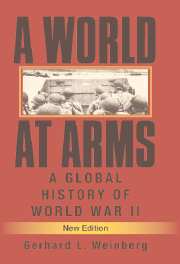Book contents
- Frontmatter
- Dedication
- Contents
- List of Maps
- Preface to the New Edition
- Preface to the First Edition
- List of Abbreviations
- Introduction
- 1 From one War to Another
- 2 From the German and Soviet Invasions of Poland to the German Attack in the West, September I, 1939 to May 10, 1940
- 3 The world Turned Upside Down
- 4 The Expanding Conflict, 1940-1941
- 5 The Eastern Front and a Changing War, June to December, 1941
- 6 Halting the Japanese Advance, Halting the German Advance; Keeping Them Apart and Shifting the Balance: December 1941 to November 1942
- 7 The War At Sea, 1942-1944, and the Blockade
- 8 The War in Europe and North Africa 1942-1943: to and from Stalingrad; to and from Tunis
- 9 The Home Front
- 10 Means of Warfare: Old and New
- 11 From the Spring of 1943 to Summer 1944
- 12 The Assault on Germany from All Sides
- 13 Tensions in Both Alliances
- 14 The Halt on the European Fronts
- 15 The Final Assault on Germany
- 16 The War in the Pacific: From Leyte to the Missouri
- Conclusions: the Cost and Impact of War
- Bibliographic Essay
- Notes
- Maps
- Index
10 - Means of Warfare: Old and New
Published online by Cambridge University Press: 05 February 2014
- Frontmatter
- Dedication
- Contents
- List of Maps
- Preface to the New Edition
- Preface to the First Edition
- List of Abbreviations
- Introduction
- 1 From one War to Another
- 2 From the German and Soviet Invasions of Poland to the German Attack in the West, September I, 1939 to May 10, 1940
- 3 The world Turned Upside Down
- 4 The Expanding Conflict, 1940-1941
- 5 The Eastern Front and a Changing War, June to December, 1941
- 6 Halting the Japanese Advance, Halting the German Advance; Keeping Them Apart and Shifting the Balance: December 1941 to November 1942
- 7 The War At Sea, 1942-1944, and the Blockade
- 8 The War in Europe and North Africa 1942-1943: to and from Stalingrad; to and from Tunis
- 9 The Home Front
- 10 Means of Warfare: Old and New
- 11 From the Spring of 1943 to Summer 1944
- 12 The Assault on Germany from All Sides
- 13 Tensions in Both Alliances
- 14 The Halt on the European Fronts
- 15 The Final Assault on Germany
- 16 The War in the Pacific: From Leyte to the Missouri
- Conclusions: the Cost and Impact of War
- Bibliographic Essay
- Notes
- Maps
- Index
Summary
LAND FIGHTING
In World War II, the major weapons systems used in World War I and in some instances further developed in the inter-war years dominated all combat well into the war. As a practical matter many countries had kept or bought stocks of World War I weapons, especially those newly made in the last months of that conflict, and used them in the initial fighting. The rifles of the earlier conflict were only slowly replaced by newer models, and the British army in the summer of 1940 was pleased to receive large shipments of American World War I rifles. The general trend in infantry weapons was, however, into a new direction.
Increasingly the belligerents introduced rifles which could fire rounds from a clip or magazine more rapidly—if less accurately—and which thus substituted volume of fire for accuracy, ironically a revival of the way muskets had been used in the seventeenth and eighteenth centuries. The same trend could be seen in the increasing introduction of relatively simply made automatic weapons, which might be called sub-machine guns or assault rifles but which shared the characteristics of rapid automatic or semi-automatic fire, short range, and low accuracy. Designed to be used in infantry combat where a large volume of fire in street fighting, ambushes, and similar situations was called for, these weapons slowly but steadily replaced rifles as a preferred weapon of the infantry. Their very rapid expenditure of ammunition, however, obviously could create supply problems, and most armies relied on rifles for much of their infantry until the end of the war.
All armies in World War II used machine guns and mortars, but the changes made in these were not particularly great. The weight of machine guns was reduced and the caliber and accuracy of mortars increased somewhat, but any World War I veteran would have had no difficulty recognizing the heavy infantry weapons of 1945. Flamethrowers were employed on a large scale, especially by the Americans in the island campaigns of the Pacific War, and some were mounted on tanks; here too new developments were not especially radical.
- Type
- Chapter
- Information
- A World at ArmsA Global History of World War II, pp. 536 - 586Publisher: Cambridge University PressPrint publication year: 2005



